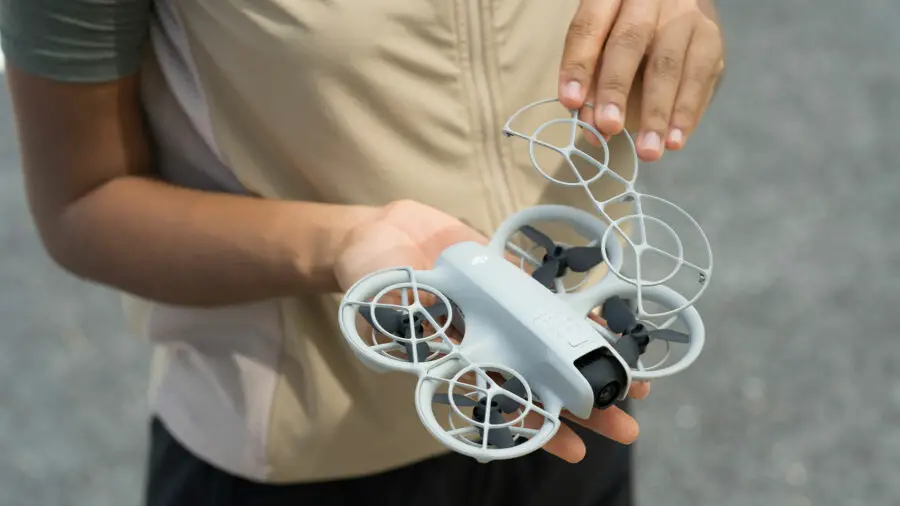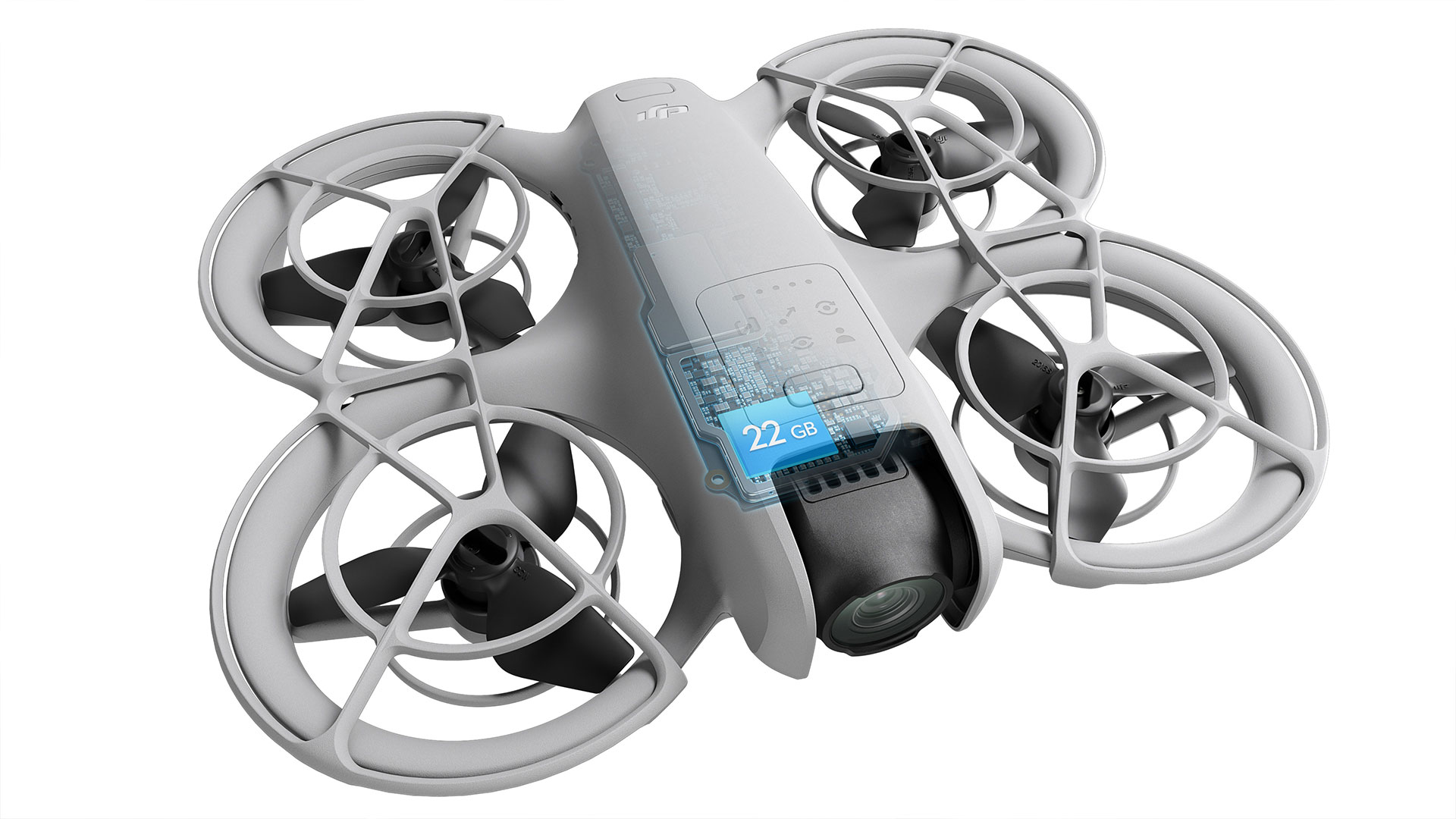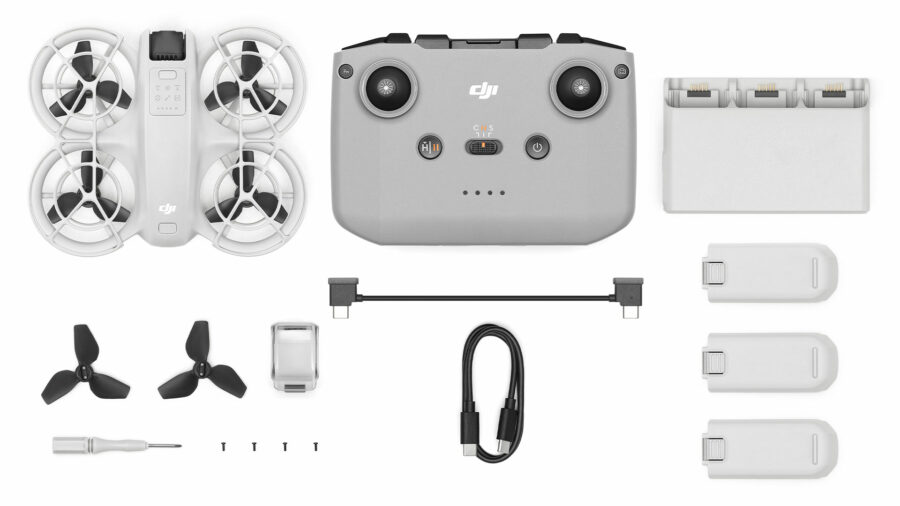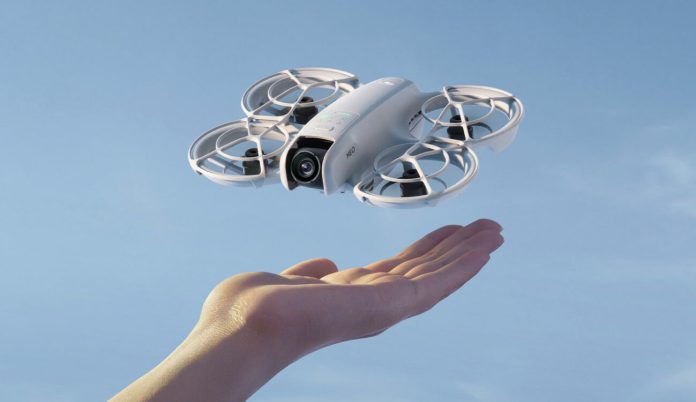DJI Neo is a new palm-sized drone weighing 135g (0.29 lb) that includes propeller protectors, automatic flight modes, smartphone control, and more. The drone, designed for creators, can take 12MP photographs and record video at up to 4K30fps (or 1080p60fps) using RockSteady (or HorizonBalancing) stabilization. The drone can fly for up to 18 minutes and is currently available for $199.

Legacy of DJI Spark
Looking at Neo’s specifications and characteristics, it’s simple to believe that this UAV will genuinely democratize drone flying. Not only is the drone small and lightweight, but it can also be handled completely without a controller or with only a phone.

This method of operating a drone is not entirely new for DJI. In May 2017, the company unveiled the DJI Spark, a small drone that could only be controlled by hand gestures or a mobile phone (in addition to the traditional remote controller). However, the new DJI Neo appears to be an upgraded Spark successor. With a takeoff weight of only 135g/4.76oz, Neo is significantly lighter than the Spark (300g/0.66 pounds). Neo’s 2-inch propellers also have prop protectors, which make the drone more robust and safe to fly around people. The DJI Neo is also far smaller than the average drone. Naturally, the camera unit provides significantly higher quality with up to 4K30fps footage (Spark could only capture at 1080p30fps). But more on that later.
DJI Neo flying
When using Neo without a controller, simply click the drone’s mode button to select your preferred shooting mode. The drone will take off autonomously from the palm of your hand and fly in one of the intelligent shooting modes. After the flight, lay your hand beneath the hovering drone, and it will automatically land on it.

At launch, five control methods are supported:
- Controller-free: Use the drone’s visual positioning system to operate without the need for any ground devices.
- Control with a smartphone—Once connected to the drone’s WiFi, use a smartphone to control it from the ground. DJI claims the drone can send a camera feed for up to 30 metres.
- Control with a normal remote controller: Use the DJI RC-N3 as the ground device, with the O4 transmission system (up to 10km in FCC mode).
- Control using RC Motion and Goggles: DJI RC Motion 3 + DJI Goggles 3, using the O4 video transmission system (up to 10km in FCC mode).
- Control with the DJI FPV Remote Controller 3 and DJI Goggles 3, which use the O4 video transmission system (up to 10km distance in FCC mode).
According to DJI, despite its lightweight design, Neo can fly normally in winds of up to 8m/s (level 4). When used with DJI Goggles 3, it can provide a supplementary live feed to a smartphone via the DJI Fly app.

The drone features an automatic follow mode with subject tracking. QuickShot modes include dronie, circle, rocket, spotlight, and custom (the drone must be connected to the DJI Fly app). Other features include DirectionTrack, Helix, and Boomerang.
Additionally, the DJI Neo acquired the Avata 2’s Easy ACRO mode. That implies the drone may perform various acrobatic moves (such as flips, rolls, and 180° drifts) with a single button press. However, you must fly Neo using the DJI RC Motion 3 controller.
Camera specs
To conserve weight, Neo does not include a three-axis gimbal-stabilized camera. Instead, it features a single-axis gimbal with an up/down tilt range of -90° to 60°.
The camera has a 12MP (4000×3000) 1/2″ image sensor and an f/2.8 ultra-wide lens with a field of view of 117.6° (equal to 14mm full-frame).
On top of 12MP (JPEG only) photos, the camera can record video in the following formats:
- 4K (4:3): 3840×2880@30fps (EIS off, can be stabilized later with Gyroflow)
- 1080p (4:3): 1440×1080@60/50/30fps (EIS off, can be stabilized later with Gyroflow)
- 4K (16:9): 3840×2160@30fps (EIS on – RockSteady or HorizonBalancing)
- 1080p (16:9): 1920×1080@60/50/30fps (EIS on – RockSteady or HorizonBalancing)
The generated MP4 video files have a maximum bitrate of 75Mbps and are only available in “normal” color mode.

Neo does not include a MicroSD card slot. Instead, it contains 22GB of internal memory. To transfer files from the drone, utilize a high-speed WiFi connection (up to 30MB/s) or a USB-C cable.
While reviewing the recording modes, I can’t help but assume that many people would have like to see a stable 9:16 recording mode in this drone, especially given that it is aimed at artists and built to transfer files directly to a phone for speedy publishing.

Audio recording via DJI Mic 2 or phone
One extremely amazing feature is that after connecting to the DJI Fly app, the DJI Neo can record audio using the DJI Mic 2, which can be linked to your mobile phone over Bluetooth or directly through the phone’s built-in microphone. The DJI Fly app automatically removes propeller noise (79dB for Neo) and blends the audio track with the drone’s video clip. This may be great for scenes in which Neo is monitoring you as you walk and converse.

Battery and charging
The 1435 mAh battery will keep Neo in the air for around 18 minutes (17 minutes with propeller guards). The drone’s battery can be charged directly using the provided USB-C to USB-C connection (maximum charging power of 15W).
The DJI Neo two-way charging hub is DJI’s first battery charging hub to provide simultaneous charging (using a charger with more than 45W allows you to charge three batteries at the same time, whereas a 30W charger can only charge two batteries). With a maximum charging power of 60W, the hub can charge all three batteries simultaneously from 0% to 100% in around 60 minutes.

Price and availability
Neo is currently available for pre-order. As always, DJI provides a few various pre-configured packages based on what you want (and this time, also depending on where you buy):
- DJI Neo standalone – mainly includes the drone and one drone battery. This version costs $199 (around €199 in Europe).
- DJI Neo Combo (only available in the USA) – mainly includes the drone and three batteries and costs $289.
- DJI Neo Fly More Combo (available globally except the USA) – mainly includes the drone, three batteries, and the standard DJI RC-N3 Remote Controller. The Fly More Combo is being sold for around €349.


